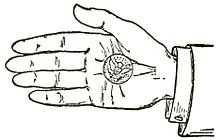Palming
For the basketball violation colloquially known as "palming", see Carrying (basketball).

Palming a coin, from early-20th century writings on magic by Ellis Stanyon.
Palming is a technique for holding or concealing an object in the palm of the hand. It is used frequently by magicians to conceal the presence of a card, coin, or other object. When it is done skillfully, the hand containing the palmed object appears to be completely empty.
Methods
Methods for palming differ depending on the object intended to be concealed.
- Card palms
- Cards can be palmed to improve many illusions, and convince the viewers that they may not have seen what they thought they had seen. To do this, start by holding the pack in the left hand, bring the right-hand over as if you're about to square up the cards. As the right hand is covering the cards and concealing them from the audience's view, you will find you are able to use your left thumb to push the top card slightly over to the right. If this is done correctly, the top right-hand corner of the pushed over card presses firmly against the top joint of the little finger of the right hand. You will find that your left thumb can now swivel the card into your right palm and with your second and third fingers, you are able to push the centre of the card upwards bending it inwards to follow the contours of your palm with the nearest bottom of the card coming to rest against the ball of your thumb.
- Coin palms
- The coin that is to be palmed is usually resting on the fingertips, on the fore and middle fingers of the hand. This position is quite flexible and will allow the coin to be easily maneuvered as the two fingers are curled into the palm or the hand is turned palm-downwards after curling the fingers to make a clenched fist. At that point, the coin is then pressed into the palm of the hand. Try to keep the thumb and forefinger touching, as that will prevent the thumb from sticking out, which would make it obvious that you are concealing a coin in the hand.
Uses
Palming an object generally allows for one of three effects to take place:
- Vanishing an object can be achieved by palming it. Used properly, the object will seem to have disappeared completely, and the performer's hands will appear to be empty. The palmed object can then be skillfully transferred to the opposite hand, or secretly disposed of, allowing the performer's hands to be shown as actually empty.
- Producing an object can also be achieved by palming it out of sight of the viewer, or after the object has been "vanished" into the palm. Proper handling can give the appearance of two empty hands, and can conceal the origin of the item.
- Transposing two different objects can be achieved by simultaneously releasing one item from a palm grip, while inserting another. In this way, a card or coin can be made to appear to change into a different type or color.